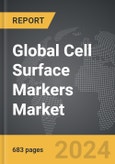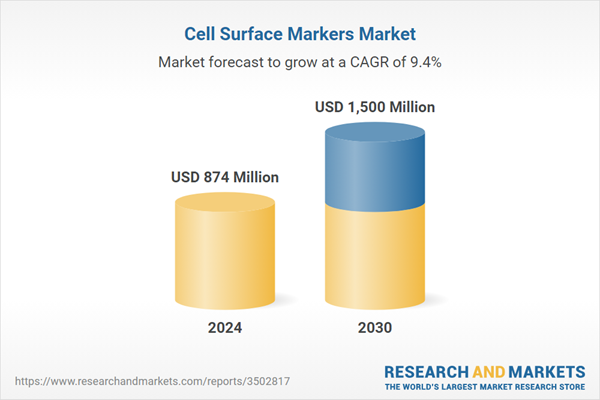The global market for Cell Surface Markers was valued at US$874.0 Million in 2024 and is projected to reach US$1.5 Billion by 2030, growing at a CAGR of 9.4% from 2024 to 2030. This comprehensive report provides an in-depth analysis of market trends, drivers, and forecasts, helping you make informed business decisions. The report includes the most recent global tariff developments and how they impact the Cell Surface Markers market.
The characterization of cell surface markers has advanced significantly with the development of sophisticated technologies such as flow cytometry, mass cytometry, and immunohistochemistry. Flow cytometry, in particular, allows for the rapid and precise analysis of multiple markers simultaneously on individual cells within heterogeneous populations. This technology has been instrumental in immunophenotyping, enabling the detailed study of immune cell subsets and their functions in health and disease. Mass cytometry, or cytometry by time-of-flight (CyTOF), expands on traditional flow cytometry by using metal-tagged antibodies, increasing the number of detectable markers and providing deeper insights into cellular complexity. Immunohistochemistry, which involves the staining of tissue sections with antibodies specific to cell surface markers, provides spatial context, allowing researchers to observe the localization and distribution of markers within tissues. These advancements have significantly enhanced our ability to diagnose diseases, monitor treatment responses, and develop targeted therapies.
The growth in the cell surface markers market is driven by several factors, including the rising prevalence of chronic diseases, advancements in technology, and increasing research and development activities. The growing incidence of cancers, autoimmune diseases, and infectious diseases has led to heightened demand for diagnostic tools that can accurately identify and characterize cell populations. Technological advancements in high-throughput screening methods and analytical techniques have made it possible to analyze cell surface markers with greater precision and at a larger scale. Additionally, the surge in personalized medicine and immunotherapy has necessitated the development of novel markers for targeted treatment strategies. Pharmaceutical and biotechnology companies are investing heavily in the discovery and validation of new markers to enhance the efficacy and specificity of therapeutics. Government funding and initiatives aimed at advancing biomedical research further support market growth. These factors collectively highlight the dynamic and expanding nature of the cell surface markers market, underscoring its critical role in advancing medical research and improving patient care.
Segments: Product (Antibodies, PCR Arrays); Cell Type (T Cell, B Cell, NK Cell, Monocyte Cell, Other Cell Types); Application (Research, Clinical); End-Use (Academic & Research Institutes, Hospitals & Clinical Laboratories, Other End-Uses).
Geographic Regions/Countries: World; USA; Canada; Japan; China; Europe; France; Germany; Italy; UK; Spain; Russia; Rest of Europe; Asia-Pacific; Australia; India; South Korea; Rest of Asia-Pacific; Latin America; Argentina; Brazil; Mexico; Rest of Latin America; Middle East; Iran; Israel; Saudi Arabia; UAE; Rest of Middle East; Africa.
The analysts continuously track trade developments worldwide, drawing insights from leading global economists and over 200 industry and policy institutions, including think tanks, trade organizations, and national economic advisory bodies. This intelligence is integrated into forecasting models to provide timely, data-driven analysis of emerging risks and opportunities.
Global Cell Surface Markers Market - Key Trends & Drivers Summarized
Cell surface markers, also known as cell surface antigens, are specific proteins or molecules present on the membrane of cells that serve as unique identifiers and play crucial roles in cellular communication and immune response. These markers are integral to various biological processes, including cell signaling, adhesion, and migration. They are often used by researchers and clinicians to identify and classify different cell types, especially in the context of immune cells. For instance, CD4 and CD8 markers are used to distinguish between helper T cells and cytotoxic T cells, respectively. The identification of these markers is pivotal in understanding the cellular mechanisms underlying various diseases, including cancer, autoimmune disorders, and infectious diseases, and they are frequently targeted in diagnostic and therapeutic applications.The characterization of cell surface markers has advanced significantly with the development of sophisticated technologies such as flow cytometry, mass cytometry, and immunohistochemistry. Flow cytometry, in particular, allows for the rapid and precise analysis of multiple markers simultaneously on individual cells within heterogeneous populations. This technology has been instrumental in immunophenotyping, enabling the detailed study of immune cell subsets and their functions in health and disease. Mass cytometry, or cytometry by time-of-flight (CyTOF), expands on traditional flow cytometry by using metal-tagged antibodies, increasing the number of detectable markers and providing deeper insights into cellular complexity. Immunohistochemistry, which involves the staining of tissue sections with antibodies specific to cell surface markers, provides spatial context, allowing researchers to observe the localization and distribution of markers within tissues. These advancements have significantly enhanced our ability to diagnose diseases, monitor treatment responses, and develop targeted therapies.
The growth in the cell surface markers market is driven by several factors, including the rising prevalence of chronic diseases, advancements in technology, and increasing research and development activities. The growing incidence of cancers, autoimmune diseases, and infectious diseases has led to heightened demand for diagnostic tools that can accurately identify and characterize cell populations. Technological advancements in high-throughput screening methods and analytical techniques have made it possible to analyze cell surface markers with greater precision and at a larger scale. Additionally, the surge in personalized medicine and immunotherapy has necessitated the development of novel markers for targeted treatment strategies. Pharmaceutical and biotechnology companies are investing heavily in the discovery and validation of new markers to enhance the efficacy and specificity of therapeutics. Government funding and initiatives aimed at advancing biomedical research further support market growth. These factors collectively highlight the dynamic and expanding nature of the cell surface markers market, underscoring its critical role in advancing medical research and improving patient care.
Report Scope
The report analyzes the Cell Surface Markers market, presented in terms of units. The analysis covers the key segments and geographic regions outlined below.Segments: Product (Antibodies, PCR Arrays); Cell Type (T Cell, B Cell, NK Cell, Monocyte Cell, Other Cell Types); Application (Research, Clinical); End-Use (Academic & Research Institutes, Hospitals & Clinical Laboratories, Other End-Uses).
Geographic Regions/Countries: World; USA; Canada; Japan; China; Europe; France; Germany; Italy; UK; Spain; Russia; Rest of Europe; Asia-Pacific; Australia; India; South Korea; Rest of Asia-Pacific; Latin America; Argentina; Brazil; Mexico; Rest of Latin America; Middle East; Iran; Israel; Saudi Arabia; UAE; Rest of Middle East; Africa.
Key Insights:
- Market Growth: Understand the significant growth trajectory of the Antibodies segment, which is expected to reach US$981.1 Million by 2030 with a CAGR of a 11.0%. The PCR Arrays segment is also set to grow at 6.6% CAGR over the analysis period.
- Regional Analysis: Gain insights into the U.S. market, valued at $402.0 Million in 2024, and China, forecasted to grow at an impressive 11.2% CAGR to reach $131.1 Million by 2030. Discover growth trends in other key regions, including Japan, Canada, Germany, and the Asia-Pacific.
Why You Should Buy This Report:
- Detailed Market Analysis: Access a thorough analysis of the Global Cell Surface Markers Market, covering all major geographic regions and market segments.
- Competitive Insights: Get an overview of the competitive landscape, including the market presence of major players across different geographies.
- Future Trends and Drivers: Understand the key trends and drivers shaping the future of the Global Cell Surface Markers Market.
- Actionable Insights: Benefit from actionable insights that can help you identify new revenue opportunities and make strategic business decisions.
Key Questions Answered:
- How is the Global Cell Surface Markers Market expected to evolve by 2030?
- What are the main drivers and restraints affecting the market?
- Which market segments will grow the most over the forecast period?
- How will market shares for different regions and segments change by 2030?
- Who are the leading players in the market, and what are their prospects?
Report Features:
- Comprehensive Market Data: Independent analysis of annual sales and market forecasts in US$ Million from 2024 to 2030.
- In-Depth Regional Analysis: Detailed insights into key markets, including the U.S., China, Japan, Canada, Europe, Asia-Pacific, Latin America, Middle East, and Africa.
- Company Profiles: Coverage of players such as Abbott Laboratories, Inc., Beckman Coulter, Inc., Bio-Rad Laboratories, Inc., Cardinal Health, Inc., BD Biosciences and more.
- Complimentary Updates: Receive free report updates for one year to keep you informed of the latest market developments.
Some of the 70 companies featured in this Cell Surface Markers market report include:
- Abbott Laboratories, Inc.
- Beckman Coulter, Inc.
- Bio-Rad Laboratories, Inc.
- Cardinal Health, Inc.
- BD Biosciences
- Bio-Techne Corporation
- Cosmo Bio Co., Ltd.
- A. Menarini Diagnostics Srl
- BML, Inc.
- Cellavision AB
- Diatron MI Zrt
- Apogee Flow Systems Ltd.
- Cytonome/ST, LLC
- Dako Denmark A/S
- ACEA Biosciences, Inc.
Tariff Impact Analysis: Key Insights for 2025
Global tariff negotiations across 180+ countries are reshaping supply chains, costs, and competitiveness. This report reflects the latest developments as of April 2025 and incorporates forward-looking insights into the market outlook.The analysts continuously track trade developments worldwide, drawing insights from leading global economists and over 200 industry and policy institutions, including think tanks, trade organizations, and national economic advisory bodies. This intelligence is integrated into forecasting models to provide timely, data-driven analysis of emerging risks and opportunities.
What’s Included in This Edition:
- Tariff-adjusted market forecasts by region and segment
- Analysis of cost and supply chain implications by sourcing and trade exposure
- Strategic insights into geographic shifts
Buyers receive a free July 2025 update with:
- Finalized tariff impacts and new trade agreement effects
- Updated projections reflecting global sourcing and cost shifts
- Expanded country-specific coverage across the industry
Table of Contents
I. METHODOLOGYII. EXECUTIVE SUMMARYALDHCD44CD90III. MARKET ANALYSISITALYSPAINRUSSIAREST OF EUROPESOUTH KOREAREST OF ASIA-PACIFICARGENTINABRAZILMEXICOREST OF LATIN AMERICAIRANISRAELSAUDI ARABIAUNITED ARAB EMIRATESREST OF MIDDLE EASTIV. COMPETITION
1. MARKET OVERVIEW
2. FOCUS ON SELECT PLAYERS
3. MARKET TRENDS & DRIVERS
CD133
4. GLOBAL MARKET PERSPECTIVE
UNITED STATES
CANADA
JAPAN
CHINA
EUROPE
FRANCE
GERMANY
UNITED KINGDOM
ASIA-PACIFIC
AUSTRALIA
INDIA
LATIN AMERICA
MIDDLE EAST
AFRICA
Companies Mentioned (Partial List)
A selection of companies mentioned in this report includes, but is not limited to:
- Abbott Laboratories, Inc.
- Beckman Coulter, Inc.
- Bio-Rad Laboratories, Inc.
- Cardinal Health, Inc.
- BD Biosciences
- Bio-Techne Corporation
- Cosmo Bio Co., Ltd.
- A. Menarini Diagnostics Srl
- BML, Inc.
- Cellavision AB
- Diatron MI Zrt
- Apogee Flow Systems Ltd.
- Cytonome/ST, LLC
- Dako Denmark A/S
- ACEA Biosciences, Inc.
Table Information
| Report Attribute | Details |
|---|---|
| No. of Pages | 683 |
| Published | April 2025 |
| Forecast Period | 2024 - 2030 |
| Estimated Market Value ( USD | $ 874 Million |
| Forecasted Market Value ( USD | $ 1500 Million |
| Compound Annual Growth Rate | 9.4% |
| Regions Covered | Global |









